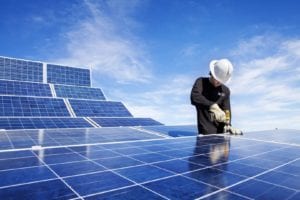By Kevin Norris, consulting solutions architect and Dave Smith, renewable energy expert
Given the current power challenges in South Africa, as well as a growing trend toward solutions for sustainable electricity, solar technology as a source of energy supply has become a hot topic, particularly for organisations wishing to reduce their reliance on utility power sources. Rooftop solar photovoltaic (PV) plants can help organisations generate their own power, and using grid tie inverter systems enables them to feed excess generated power back to the utility for use elsewhere. However, despite the benefits of such systems, there are two common challenges that have emerged. Firstly, PV plants are a costly investment, and the return on investment (ROI) has in the past taken many years to realise, although this is changing as the cost of installation reduces and electricity tariffs continue to increase. This makes obtaining funding for such systems difficult. Secondly, there remain several issues with the connection of solar plants to the main grid, which has slowed the uptake of these solutions. Addressing these challenges is key to harnessing the power of the sun as an alternate, sustainable energy source.Using an inverter
Grid tie solar systems are the simplest and most cost effective method for using solar energy as a replacement for day-to-day power requirements. On a very basic level, the grid tie invertor converts the direct current (DC) power generated by solar panels, into the alternating current (AC), and injects this AC current into the existing load. Any excess energy is then fed into the power distribution network. The inverter is also able to ensure that energy requirements are drawn from available solar power first, and only utilise utility supply should there be a solar shortfall. This system does not necessarily require a battery for energy storage, although this will extend functionality, so the installation is very simple and efficient, and maintenance is low. However, while the cost of manufacturing solar PV panels and grid tie inverters has reduced over the past few years, as a result of increased demand, greater economies of scale and technological advancements, solar remains a costly solution to implement. The high cost of raw materials and the high-tech conditions required for the manufacture of components keep these solutions out of reach of the average homeowner or business.Seeking a return
Justifying this investment is often one of the biggest challenges to the implementation of solar power solutions, and obtaining loans and funding is typically a difficult sell. ROI takes a few years to realise, and the investment will only typically pay for itself within six to 10 years. The rate of return is dependent on a number of factors, including the type of installation and the existing tariff with the utility. However, what needs to be kept in mind is that solar PV systems have a predictable performance curve of 25 years and a usable life of 35 years. In addition, using a grid tie inverter system, homeowners and businesses will one day be able to feed excess power back to the grid, either offsetting this against utilisation costs or selling this power to the utility provider. PV systems therefore should not be seen as a depreciating asset. They are in fact an asset that not only reduces current costs, but in the long run could be a significant income generator for the owner. To quantify this value is a relatively simple mathematical exercise with the assistance of financial models. In 2015 the average cost of electricity per kilowatt-hour (kWh) is similar to the Lifecycle Levelised Cost of Energy of a typical grid tie system at around R1.00 per kWh. This means that, calculated over the complete guaranteed performance lifespan of the panels (about 25 years), the cost per kWh from a solar PV system will be similar to the municipal cost in 2015. Looking ahead, the cost of electricity from the utility is very likely to increase significantly year on year, while the cost of the installed PV system will remain at its installed price plus the minimal cost of maintenance. Looking at this over the next 10 years, the cost of solar generation would be around R1.00 per kWh, while the utility cost is forecast to be as high as R3.50 per kWh. This same trend is likely to continue over the lifespan of the solar PV system. If you project these increases over the 25-year period, the cost difference between now and then would be significant.Effectively, within this period, the solar PV solution could still be generating electricity at R1.00 per kWh, whereas by that stage the cost of utility power will doubtless have increased many times.
It is these future differences in the cost of energy between the utility costs and the fixed solar PV cost that should be recognised as part of the long-term sustainability of owning such an asset. Additionally, in most cases the asset is attached to a building and would result in improved valuation of the building. Not only does this have a positive financial implication, it also has an environmental implication, especially when one considers the Carbon Tax that will be levied as of 2016. The only way to negate the carbon tax is to either recycle or produce “green kWh” from a renewable source like solar PV.







